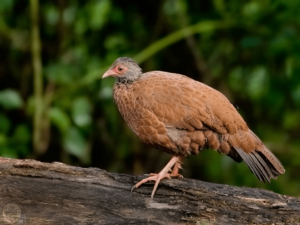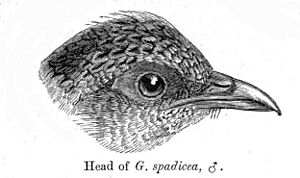Red spurfowl facts for kids
Quick facts for kids Red spurfowl |
|
|---|---|
 |
|
| Conservation status | |
| Scientific classification | |
| Genus: |
Galloperdix
|
| Species: |
spadicea
|
The red spurfowl (Galloperdix spadicea) is a bird that belongs to the pheasant family. It is found only in India, meaning it is native to that country.
This bird lives in forests and is quite shy, even though it's a good size. It has a special call that helps identify it. You might only see it for a moment when it quickly flies out from bushes. The red spurfowl looks reddish and similar to a partridge with a long tail. The skin around its eyes is red. Both male and female red spurfowls have one or two sharp spurs on their legs, which is how they got their name.
Contents
About the Red Spurfowl
Scientists give animals special names to help identify them. The red spurfowl's scientific name is Galloperdix spadicea. The first part, Galloperdix, comes from Latin words meaning "farmyard cock" and "partridge." The second part, spadicea, means "chestnut-coloured" or "date-coloured," describing its reddish-brown look.
There are three main types, or subspecies, of red spurfowl:
- G. s. spadicea: Found in western Nepal and northern and central India.
- G. s. caurina: Lives in southern Rajasthan in western India.
- G. s. stewarti: Found in central and southern Kerala in southern India.
Female red spurfowls in the southern parts of their home range tend to be darker in color. In the Marathi language, people sometimes call this bird Kokee-tree. This name probably sounds like the bird's call.
What Does It Look Like?
The red spurfowl is a reddish-brown bird that looks a bit like a large partridge. It has a fairly long tail. Its upper body is brown with dark stripes. The male's face and neck are more grey. The underside of the bird is reddish-brown with dark marks.
Both male and female red spurfowls have a patch of red skin on their face and red legs. They usually have one or two spurs on their legs, though sometimes females might not have any. Young chicks have a plain cinnamon-brown head. They also have a dark brown stripe down their back, bordered by creamy white lines. The male of the G. s. stewarti type, found in Kerala, is special because it is entirely chestnut-coloured, even its head feathers. Both male and female red spurfowls have long feathers on their head that they can raise up like a crest.
Where Do They Live?
Red spurfowls live in areas with bushes, dry forests, and moist forests. They often prefer hilly places. You can find them across India, south of the Ganges River. They like areas with plenty of plants growing close to the ground, even places with the Lantana plant, which can sometimes spread too much.
Behavior and Life Cycle
Red spurfowls usually search for food in small groups of three to five birds. When they walk, they sometimes hold their tail straight up, like a chicken. They are usually quiet during the day. However, they call out in the mornings and evenings.
They eat seeds that have fallen to the ground, berries, and insects. They also swallow small stones, called grit, to help them digest their food. When startled, they usually fly only a short distance. They stay in the same areas all year round. At night, they sleep in trees.
Their calls include a clear ker-wick...kerwick... sound and harsh karr...karrr... notes.
Reproduction
The red spurfowl's breeding season is from January to June, mostly before the rainy season starts. They build their nests on the ground. A female will lay 3 to 5 eggs in a simple hollow in the ground. Male red spurfowls usually stay with one female. This often means the male helps care for the young, but they do not sit on the eggs to keep them warm. Males have been seen trying to distract predators when a female and her chicks are nearby.
Images for kids





